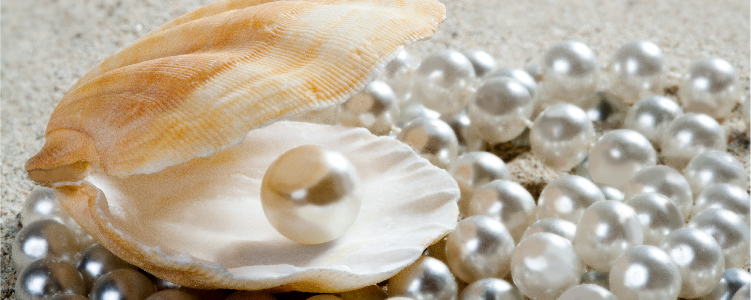Pearls are lustrous hard stones that are made from molluscs. Out of the 8,000 different species of molluscs, about 20 are capable of regularly making pearls. These pearls are cultivated with great care in controlled environments.
Table of Contents
Cultured Pearls
Originally pearls were collected by divers in oceans and rivers, but now pearl culture has made it easier to increase the yield. Early pearl cultivation involved planting a nucleus in wild oysters or implanting a tiny piece of pearl mantle in the oysters. The breakthrough was made when Japanese scientists identified strains of oysters with the best pearl-bearing qualities and focused on using them to produce pearls of high lustre and best quality. Tokichi Nishikawa and Tatsuhei Mise independently discovered the method of inserting beads and bits of the oyster mantle to stimulate pearl production.
In 1893 Kokichi Mikimoto became the champion of pearl culturing when he began embedding a variety of materials inside oysters to experiment with creating perfect saltwater pearls. He succeeded in the year 1905 and was awarded his patent in three years. His pearl farm had 12 million oysters and manufactured three-quarters of the world’s pearls. This became the most dominant technique in the world for pearl production and had completely supplanted the search for natural pearls. Cultured pearls became more and more famous because they were much easily available than Natural Pearls.
Cultured pearls are of two types – freshwater and saltwater. Freshwater pearls hold a lower value but can be found in a great number of shapes and colours. Saltwater pearls are categorized based on their origin. They are – Akoya, Tahitian, and South Sea pearls.
The Process of Making Cultured Pearls
The process of cultured pearls requires three prime raw materials which are oysters and molluscs, the nucleus that is to be implanted (live tissue from the mantle or lip from another oyster) and water. Though Akoya oyster and Biwa mussels may be known as the best pearl bearers, different types of oysters or mussels produce different varieties.
Pearl producers claim that freshwater pearls are more natural because nuclei are not used, instead only a piece of the mantle is implanted to culture the pearls. All the pearls are real, but the requirement of human intervention is what makes cultured pearls, ‘cultured’.
- First, the ‘irritant’ is surgically implanted in the oyster as the nucleus is made from the shell of a mussel. Technicians open the live pearl oysters and then carefully implant the bead. The oyster then secrets layers of nacre. This step requires tremendous skill and precision. The oysters will only allow their shells to be pried open 2 to 3 cms or they will reject the nucleus.
- The nucleated oysters are returned to the sea, in individual mesh pockets that are suspended from floating rafts. These oysters feed and grow in sheltered nets rich in natural nutrients. They are also protected from every conceivable threat to ensure the finest resulting pearls. As time passes by, they secret precious layers of nacre and make the pearl. In winter, the oysters are moved to warmer waters because cold temperatures slow down the nacre secretion. Pearl technicians monitor water temperatures and feeding conditions daily at various depths and move the oysters to provide the best growing conditions possible. They are also lifted from the sea for cleaning, healthcare and are treated with compounds to prevent parasites from injuring the flesh of the oyster.
Harvesting Cultured Pearls
The oysters are harvested during the winter season depending on the desired size and diameter of the pearl. This season also creates the best colour and lustre. The time of culturing ranges from one to three years and can be monitored with x-rays. These oysters are lifted from the sea and are brought back to the shore. Of the million oysters nucleated every year, only a tiny fraction of them produce high-grade pearls. Half of the nucleated oysters do not even survive to bear pearls and less than five per cent of the survivor’s yield pearls of the idealness considered to be fine quality pearls.
The pearls are carefully cut out and productive oysters can be reseeded several times to produce larger pearls. The pearls that make the cut are cleaned soaked and sorted. They go through a gentle series of treatments before they are made into jewellery. They are soaked for several days in a mild cleaning solution under intense fluorescent light to remove deposits and odours. They are then bathed in a wooden vat of finely crushed walnut shells.
The pearls are then matched with each other. To assemble a single strand, workers go through thousands of pearls to find ones that match for size, shape, colour, lustre and surface quality. They are sieved to separate them into different size groups. Sorted into batches according to shape, body colour, overtone and finally, the quality that takes months to complete! On completing this process, the pearls are finally drilled and mounted and ready to be made into precious jewellery and much more. The by-products of these pearls are also valuable products being made into jewellery, buttons, and furniture. The oyster meat too is harvested and fried for sale. What about the flawed pearls? They are ground into a powder and made into tablets and sold for medicinal purposes and also used for cosmetics.
In conclusion, the tedious process and effort that goes into pearl farming make this gemstone the most special one. Nobody could say no to a perfectly round and identical pearl necklace which we now know, that took a lot of painstaking hard work in making it.

